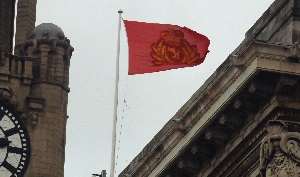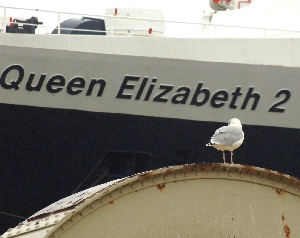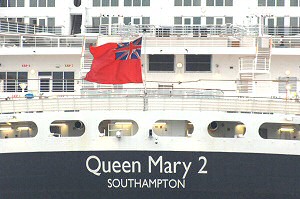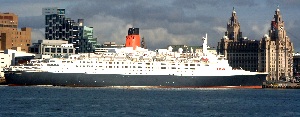|

THE company was founded by Sir Samuel Cunard in 1839. It
started out life thanks to winning the very first British Trans-Atlantic
steamship mail contract, which took its fleet of just 4 paddle steamers on round
trips, sailing out of Liverpool to Halifax to Boston route and back again.
Surprisingly it was not at 1st called Cunard, but, in fact, it was originally
called the British and North American Royal Mail Steam Packet Company!
The name Cunard was to come into existence in the 1870's. The then British and
North American Royal Mail Steam Packet Company was lagging behind its then
rivals, the White Star Line and the Inman Line and they faced going under.
Thanks to some fantastic financial moves the firm reorganised as Cunard
Steamship Company, Ltd and was able to raise capital in order that it could take
on the competition.
In the early 1900's Cunard was again facing problems, but the British Government
was to step in and they provided Cunard with substantial loans and a subsidy to
build 2 new superliners, that Cunard badly needed to retain its competitive
position. This was to lead to the building of RMS Mauretania. She was the
largest liner from her launch in 1906 until 1911 when White Star Line's RMS
Olympic was launched. But RMS Mauretania was to hold the Blue Riband from 1909
to 1929. Both the Mauretania and her running mate Lusitania were fitted with
revolutionary new turbine engines, these let them to maintain a service speed of
25 knots. In 1915, the sinking of the Cunard Line's Lusitania was to lead to the
United States' entering the 1st World War.
In the 1920's Cunard faced new competition when the Germans, Italians and French
built large prestige Liners, along with financial problems due to a fall in
passenger numbers because of the Great Depression, they had to suspend
construction on its own new superliner. Again, the British Government offered
Cunard loans to finish Queen Mary and to build a 2nd ship that was to be called
the Queen Elizabeth. This loan had though as the payment carried a condition
that Cunard would have to merge with the then ailing White Star Line to form
Cunard White Star Ltd. Cunard then became the owner of ⅔ of the new company.
When war broke out again in 1938 with the start of World War 2, the firm was
once again the largest Atlantic passenger line. Many of the ships Cunard's fleet
where refurbished into a troop carriers over World War 2. The RMS Queen
Elizabeth was to become one of the most well known of the fleet, but at 1st,
straight out of production, She was entered into service in February 1940 as a
troopship in World War II. It was not until October 1946 that the RMS Queen
Elizabeth was to serve in Her intended role as an ocean liner! At one stage the
British Admiralty considered turning the lines Queen Elizabeth along with Queen
Mary into aircraft carriers, thankfully, that did not happen.
In the 1950's the line was to operated 12 ships to the United States and Canada
and the firm was again back on form, but this rise was to be short lived. Thanks
to the introduction of jet airliners, the Trans-Atlantic passenger ships became
increasingly unprofitable. Cunard withdrew in 1968 started to concentrate on
cruising and summer transatlantic voyages for vacationers. The decline in the
popularity of the trans-Atlantic route lead to both of the Cunard's Queens being
retired and replaced by the Queen Elizabeth 2, in 1969. Sadly for the RMS Queen
Elizabeth, Her retirement led to Her being sold to the City of Long Beach,
California, in the USA. The plans Her new owners had for Her fell through and
She was again sold. This time she was sold to a Hong Kong Businessmen, Tung Chao
Yung, in 1972. He had intended to convert her into a floating university cruise
ship, but as She was undergoing refurbishment, She caught fire under mysterious
circumstances. To try and put the fire out, they pumped large amounts of water
on her, but this lead to her capsizing. Then in 1973 she was scrapped in situ,
deemed as a dangerous obstruction to Hong Kong harbour.
Cunard acquired the Norwegian America Line in 1983, under the direction
Trafalgar House Co. With this purchase, Cunard had gained now 2 superb liners,
the Sagafjord and Vistafjord (later Caronia). The group also tried to acquire
P&O. After Trafalgar attempted that same year to do a hostile takeover of P&O,
the British Monopolies and Mergers Commission then stepped in at the request of
P&O. Trafalgar then decided against proceeding with taking over P&O even though
the Commission had ruled in its favour.
The Queens were replaced by Queen Elizabeth 2 (QE2), which was designed for the
dual role in 1969.

Queen Elizabeth 2 (QE2) dual role was to lead her like the other
Cunard Queens into conflict, when the Falklands War started in 1982, but this
was to become a blessing for the firm. She was quickly refitted in Southampton
for war service. During the Falklands War she acted as a hospital ship and as a
troop carrier, aided by the installation of a 2nd helicopter pad and the
installation of fuel pipes to allow for refuelling at sea. The QE2 returned to
the UK in June 1982, where she was greeted in Southampton Water by The Queen
Mother on board the Royal Yacht Britannia. The TV footage watched by a relived
Nation was filled with footage of her return, winning the hearts of the British
public in the process and setting Her down as a symbol of Britishness.
In 1988, Cunard acquired Ellerman Lines, and then in 1994 Cunard purchased the
rights to the name of the Royal Viking Line and its Royal Viking Sun, but it was
not all plain sailing.
During the start of the 1990's Cunard fleet was showing its age and it only got
worse when the QE2 experienced numerous defects in 1994.
In 1998 Cunard was acquired by Carnival Cruises and made a subsidiary of the
Plc. It's accusation merged the management of Cunard with Seabourn Cruises,
their other luxury brand.
By 2001 Carnival was the largest cruise company, followed by Royal Caribbean and
P&O Princess Cruises.

In 2004, Queen Mary 2 was to arrive and the forever loved
Queen Elizabeth 2 (QE2) was no longer the flagship of Cunard Line.
Christened by Queen Elizabeth II the public and media soon renamed Her
the QM2, in honour of the then legendary QE2. Also in 2004 Cunard Line
moved under the Princess/P&O Cruises umbrella.
In 2007 Cunard acquired another large
size cruise ship, this was the Queen Victoria, or QV, was originally
ordered by Carnival Cruise Line as a Vista class cruise ship for another
of the Carnival owned cruise lines; Holland America Line.
On 10 September 2007, The Queen
Elizabeth 2 (QE2) visited Liverpool for the very last time, on Her 40th
birthday and in also helping to mark Liverpool's 800th Anniversary year.

In 2008 Queen Elizabeth 2 (QE2) was
sold in the hopes that it would be turned into a floating hotel in
Dubai.
In 2009, executive control of Cunard
Line was subsequently transferred from Carnival Corporation in the
United States, to Carnival UK, the primary operating company of Carnival
Plc.
.jpg)
A 2nd Vista class cruise ship was also to joined the Cunard
fleet, Queen Elizabeth in 2010.
.jpg)
In a surprising move all 3 Cunard ships in service changed vessel
registry to Hamilton, Bermuda. This marked the end of a 171 year history, with
the company having none of its ships registered in the United Kingdom. This move
lets the captains of ships marry couples at sea, opening up a new market. Sadly
it is not possible for ships registered in the UK to do this.
Sadly like RMS Queen Elizabeth, Queen Elizabeth 2 (QE2)
retirement in 2008 has to lead to Her being sold from 1 failed project to
another. Then in December 2012, it was reported that QE2 had been sold for
scrapping in China for £20 million, after a bid to return her to the UK was
rejected. But later on, in January 2013 it was reported that She was to serve as
a floating luxury hotel, shopping mall, and museum. She now remains laid up in
Port Vila, Vanuatu, Dubai, United Arab Emirates.
.jpg)
In 2015 The Queen Mary is still the flagship, and she is about
twice the size of the other 2 and incidentally 5 times bigger than Britannia,
the 1st Cunarder's to cross the Atlantic from Liverpool, the RMS Unicorn, RMS
Britannia and the RMS Acadia.
If you attended please take a photo and
Twitter
it with:-
With @SouthportReport @ #3Queens
#Cunard175 #OMCLiverpool
|
